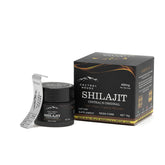In Pakistan, Shilajit—often called “Salajeet”—is a deeply ingrained part of traditional and herbal medicine, especially among communities living near mountainous regions like Gilgit-Baltistan and Chitral, where it is naturally sourced. It is prized as a natural source of energy, a powerful antioxidant, and an overall vitality booster—an ancient remedy believed to be a panacea for various ailments.
However, just like any powerful natural substance, Shilajit comes with a critical caveat: its safety hinges almost entirely on its purity and proper usage. In a market where regulation can be inconsistent, understanding the potential risks and necessary precautions is not just advisable—it’s essential for your health.
This in-depth guide provides a clear, human-toned look at the side effects and precautions you need to know about Shilajit, particularly within the context of Pakistan.
The Elephant in the Room: The Purity Problem and Heavy Metals
When discussing Shilajit’s safety, the conversation must start here. Shilajit is a sticky, tar-like substance that oozes from mountain rocks, formed by the decomposition of plant and microbial matter over centuries. While this process enriches it with beneficial minerals and fulvic acid, it also means that, in its raw, unprocessed form, it can be contaminated with harmful substances from the environment.
The Dangers of Unpurified Shilajit
Raw or poorly processed Shilajit can contain:
- Heavy Metals: This is the most significant concern. Studies have shown the presence of heavy metals like lead (Pb), mercury (Hg), arsenic (As), cadmium (Cd), and even the highly toxic thallium (Tl). While some lab-tested Shilajit samples from regions like Gilgit and Chilas in Pakistan have shown heavy-metal concentrations within permissible limits set by the World Health Organization (WHO), this is not a guarantee for all products on the market. The source of the resin and the purification process are highly variable. Ingesting these toxins, even in small doses over a long period, can lead to metal poisoning, causing severe damage to the liver, kidneys, nervous system, and other organs.
- Microbial Contaminants: Raw Shilajit can also be contaminated with mycotoxins and various fungal organisms and pathogens, which are not fit for human consumption and can lead to serious health issues.
The Golden Rule: Never consume raw or unpurified Shilajit. Always ensure you are purchasing a product that explicitly states it has been purified and, ideally, lab-tested by a credible third party for heavy metals and contaminants. Look for brands that can provide a Certificate of Analysis (COA).
Common Side Effects: What to Expect
Even when using purified, high-quality Shilajit, some mild side effects can occur, especially when you first start taking it or if the dosage is too high.
1. Digestive Discomfort
This is one of the most frequently reported side effects. Shilajit can sometimes cause gastrointestinal upset, which may manifest as:
- Nausea or Vomiting: Especially if taken on an empty stomach.
- Diarrhea: Your body reacting to the new substance.
- Upset Stomach: A general feeling of discomfort or mild acidity.
Pro-Tip: To minimize this, start with a very low dosage and gradually increase it. Many people find that taking Shilajit with warm milk or water, or after a light meal, significantly improves tolerance.
2. Allergic Reactions and Rashes
While rare, some individuals may be sensitive or allergic to the mineral content in Shilajit. Symptoms can include:
- Skin Rashes or Hives: Itching or blotches on the skin.
- Dizziness or Lightheadedness: A mild feeling of disorientation.
- Increased Heart Rate (Tachycardia): A noticeable increase in your pulse.
Action: If you experience any signs of a severe allergic reaction—such as difficulty breathing, or swelling of the face, tongue, or throat (anaphylaxis)—stop taking the supplement immediately and seek emergency medical help.
3. Iron Overload
Shilajit is a rich source of iron. While this is beneficial for most, it can be a problem for people with a condition called hemochromatosis (a disorder causing the body to absorb too much iron). For these individuals, the extra iron from Shilajit can build up in organs, leading to iron toxicity.
Precaution: If you have any blood disorder or a tendency toward iron overload, consult a physician before starting Shilajit.
Critical Precautions and Contraindications
This section highlights conditions or circumstances where Shilajit should be avoided or used with extreme caution under professional medical supervision.
1. Blood Pressure Issues
Shilajit has been observed to have a blood-pressure-lowering effect.
- Danger for Low Blood Pressure (Hypotension): If you already suffer from low blood pressure, Shilajit could potentially drop it to dangerous levels.
- Interaction with Hypertension Medication: If you are taking medication for high blood pressure, combining it with Shilajit could lead to your blood pressure dropping too low.
Recommendation: If you have a heart condition or are on blood-pressure medication, do not take Shilajit without consulting your cardiologist or physician first, and monitor your blood pressure closely.
2. Diabetes and Blood Sugar
Shilajit may lower blood glucose levels.
- Interaction with Diabetes Medication: If you are taking anti-diabetic medications (like insulin or metformin), adding Shilajit could dangerously lower your blood sugar, leading to hypoglycemia.
Recommendation: Diabetics must monitor their blood sugar levels carefully and consult their doctor before incorporating Shilajit into their regimen.
3. Pregnancy and Breastfeeding
The official medical stance is to avoid Shilajit during pregnancy and breastfeeding.
- Lack of Data: There is currently insufficient reliable information and a lack of scientific studies to confirm the safety of Shilajit for the pregnant mother and the developing baby or nursing infant.
Recommendation: To stay on the safe side, it is strongly advised to refrain from using Shilajit if you are pregnant or breastfeeding. Consult your healthcare provider for safe alternatives.
4. Autoimmune Diseases
Shilajit is often marketed as an immune-boosting supplement.
- Risk: In individuals with autoimmune disorders (such as lupus, multiple sclerosis, or rheumatoid arthritis), a substance that boosts the immune system could potentially exacerbate the condition, as these diseases involve an overactive immune system attacking the body’s own tissues.
Recommendation: If you have an autoimmune condition, avoid Shilajit or seek specific advice from a specialist physician.
5. High Uric Acid Levels or Gout
Some data suggests that Shilajit may raise uric-acid levels, which is a concern for individuals who are prone to gout (a painful form of arthritis caused by uric-acid crystals) or kidney stones.
Recommendation: If you have a history of gout or high uric-acid levels, consult your physician and monitor your serum uric-acid levels if you decide to use the supplement.
6. Before Surgery
Due to its potential to affect blood sugar and blood pressure, Shilajit may interfere with their control during and after surgical procedures.
Recommendation: It is generally recommended to stop taking Shilajit at least two weeks before any scheduled surgery.
Practical Tips for Safe Consumption in Pakistan
In Pakistan, where Shilajit is often available through traditional hakeems or local vendors, exercising caution is paramount. Best practices include:
-
Prioritize Purity (the single most important step):
- Only purchase purified Shilajit (resin, powder, or capsules). Raw, unprocessed material is dangerous.
- Buy from reputable sources and, if possible, look for products that are lab-tested or have certification of purity.
-
Consult a Professional:
- Always speak with a qualified doctor (MBBS, MD) or a recognized herbal/Ayurvedic practitioner before starting Shilajit, especially if you have an underlying medical condition, are on any long-term medication, or are an older adult.
-
Start Low, Go Slow (dosage):
- Begin with the lowest recommended dose—typically around 200–300 mg per day.
- Observe your body for any adverse reactions for a week or two before considering a gradual increase, staying within the commonly recommended maximum of 500 mg per day (or as advised by your doctor).
-
Listen to Your Body:
- If you experience persistent nausea, severe headaches, dizziness, or an allergic reaction, stop taking it immediately.
-
Stay Hydrated:
- Shilajit can increase metabolism, which may lead to fluid loss. Drink plenty of water throughout the day.
-
Timing:
- Take Shilajit in the morning for its energy-boosting effects and to avoid restlessness at night.
- Consume it with food or a liquid like warm milk or water to aid absorption and reduce gastrointestinal upset.
In conclusion, Shilajit is a venerable substance with a long history of use and potential benefits. For healthy individuals using a high-quality, purified product in recommended doses, it is generally considered safe. However, the presence of low-quality, contaminated Shilajit in the market—combined with its strong effects on blood pressure, blood sugar, and hormones—makes careful, informed use and consultation with a healthcare professional the only responsible approach. Your well-being is priceless; treat this potent substance with the respect and caution it deserves.








